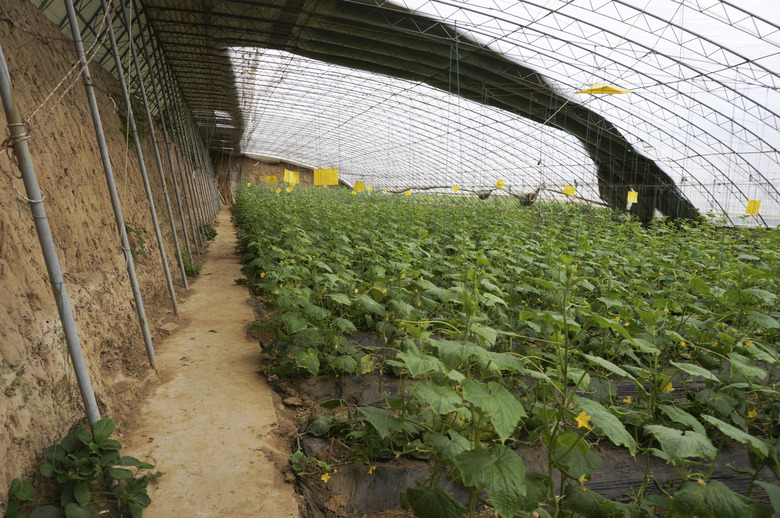What Shade Cloth Density Allows Vegetables To Grow?
Shade cloth, a knitted polyethylene fabric, blocks the sun's radiation on crops grown in open fields, greenhouses and high tunnels. Purchased in densities that correlate to the percentage of light blocked by the cloth, shade cloth most often used for vegetables ranges from 20 percent to 40 percent, with 30 percent the most common. The shade cloth density that best allows vegetables to grow, however, depends on the climate, the season and the vegetable crops that are being grown.
Step 1
Shade cloth protects vegetables grown in greenhouses and fields from summer heat buildup and lowers air temperature around the plant. Depending on the density of the cloth, the fabric can lower air temperatures by as much as 10 degrees Fahrenheit. When used on high tunnels and enclosed greenhouses, it also has the ability to help retain heat at night. Shade cloth is permeable, allowing rainfall to irrigate field-grown crops.
Adjusting Shade for Seasons
Step 1
Greenhouse gardeners with cool springs may not need to employ shade cloth until late in the spring or early summer, and it may not be necessary until the heat of midsummer for field growing. In warmer climates where heat buildup under high tunnels and greenhouses begins earlier in the season, shade cloth used over tomatoes (Solanum lycopersicum) and peppers (Capsicum annuum) will begin earlier. For example, in Florida, growers may use 20 percent shade cloth in March and April, switching to 30 percent shade cloth in May and June. During midsummer, even heavier shade cloth may be required. The shade cloth is typically removed in October and November as seasonal temperatures drop.
Step 2
Step 3
- Shade cloth protects vegetables grown in greenhouses and fields from summer heat buildup and lowers air temperature around the plant.
- Depending on the density of the cloth, the fabric can lower air temperatures by as much as 10 degrees Fahrenheit.
Adjusting Shade by Crops
Step 1
Commercial vegetable growers employ shade cloth to help them increase production, as can home gardeners. Tomatoes and peppers will stop growing at temperatures of 95 degrees Fahrenheit and fail to set fruit. For pepper and tomato production in hot summer areas, 30 percent shade cloth is recommended. Likewise, high temperatures can keep cool-season crops like lettuce (Lactuca sativa) and spinach (Spinacia oleracea) from growing properly. For cool-season crops, 30 percent shade cloth is used in cool-summer climates and 47 percent in hot-summer climates.
Step 2
Shade Cloth Installation
Step 1
Shade cloth is typically installed on the outside of high tunnels and greenhouses, and over simple post and wire frames on outdoor-grown vegetables. Attach cord or rope to the grommets on the cloth and secured the rope to the outside of the tunnel or greenhouse frames or to the framing for field-grown crops. The cloth can be rolled up on cloudy days when it is not needed and removed at the end of the season for storage.
Step 2
- Commercial vegetable growers employ shade cloth to help them increase production, as can home gardeners.
- Shade cloth is typically installed on the outside of high tunnels and greenhouses, and over simple post and wire frames on outdoor-grown vegetables.
References
- Growers Supply: Shade Material Buyer's Guide
- University of Delaware Cooperative Extension: Shadecloth for Hot Season Vegetable and Fruit Production
- Advance Greenhouses: How to Use Shade Cloth on the Greenhouse
- Harvest to Table: Shade: Hot Weather Vegetable Garden Protection
- Sustainable Market Farming; Pam Dawling
